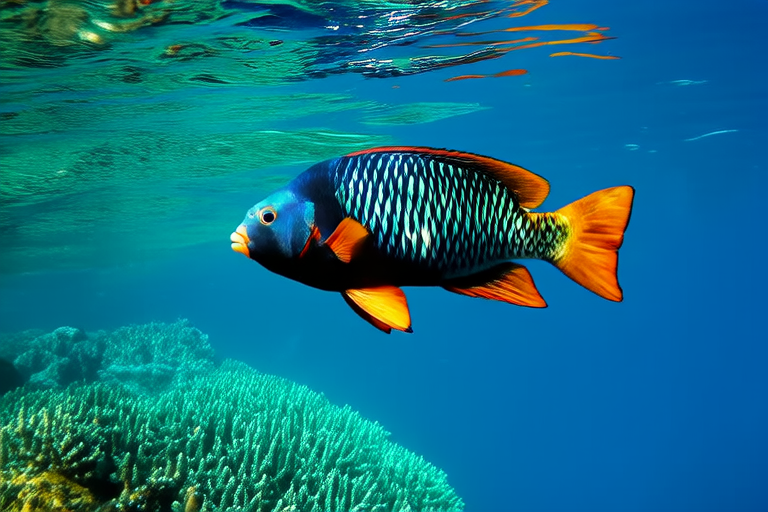
The Lifecycle, Diet, and Ecological Role of Parrot Fish
Parrot fish, with their vibrant colors and unique feeding behavior, play a crucial role in maintaining the health of coral reefs. These fish are not only visually stunning but also have an intricate lifecycle and diet that sets them apart from other marine species. This article delves into the lifecycle, dietary habits, and ecological role of parrot fish, shedding light on their surprising contributions to marine ecosystems and the seafood industry.
Lifecycle of Parrot Fish
The lifecycle of parrot fish begins with spawning, where females release hundreds or thousands of eggs into the water. These eggs float near the surface until they hatch. The larvae then drift with ocean currents, eventually settling on coral reefs. As they grow, parrot fish undergo a remarkable transformation, changing color and shape as they mature. Juvenile parrot fish often resemble other species, a strategy that helps protect them from predators. As they grow, they develop their characteristic bright colors and distinctive beak-like mouths, which are used for scraping algae off coral.
Dietary Habits: Coral Consumers
Parrot fish are known for their unique feeding behavior, consuming vast amounts of coral each day. They use their powerful beaks to scrape algae and polyps off coral surfaces. This feeding process not only provides them with nutrients but also plays a vital role in reef health. By removing dead and dying coral tissue, parrot fish help maintain the balance between algae and coral growth, preventing algae overgrowth that could otherwise smother corals.
Vibrant Colors and Camouflage
Parrot fish exhibit a wide range of vibrant colors, from electric blues and greens to fiery oranges and reds. These colors serve multiple purposes. Firstly, they act as camouflage, helping the fish blend into their surroundings among the coral reefs. Secondly, these colors play a role in communication, signaling readiness to mate or indicating territorial boundaries. The diversity in coloration is also linked to the fish’s age and gender, with younger and male fish often displaying more striking hues.
Ecological Role: Reef Health Maintainers
Parrot fish contribute significantly to reef health through their excretions. After consuming coral and algae, their digestive system breaks down the calcium carbonate found in coral skeletons, turning it into sand. This process is crucial for maintaining the structure and composition of coral reefs. Without parrot fish, many coral reefs would become overgrown with algae, leading to a decline in biodiversity and ecosystem health.
Influence on the Seafood Industry and Local Economies
While parrot fish are primarily known for their ecological roles, they also have surprising implications for the seafood industry and local economies. In some regions, parrot fish are considered a delicacy and are caught for human consumption. Their meat is highly valued for its taste and nutritional content, making them an important part of the seafood market. Additionally, the vibrant colors of parrot fish make them popular in the aquarium trade, further contributing to economic activities related to marine life.
Threats to Parrot Fish Populations
Despite their importance, parrot fish populations face several threats. Overfishing is one of the most significant challenges, as these fish are targeted for both food and the aquarium trade. Habitat destruction due to coastal development and pollution also poses a risk. Climate change, which leads to coral bleaching and increased ocean acidity, further threatens the survival of parrot fish by reducing the availability of their preferred habitats and food sources.
Conservation Efforts
To address these threats, various conservation efforts are underway. Marine protected areas (MPAs) are established to safeguard critical habitats and allow fish populations to recover. Sustainable fishing practices, such as catch limits and gear restrictions, are implemented to prevent overfishing. Public awareness campaigns aim to educate consumers about the importance of choosing sustainably sourced seafood. Additionally, research initiatives focus on understanding parrot fish biology and ecology better, providing valuable information for effective conservation strategies.
Dispelling Myths About Parrot Fish
One common myth about parrot fish is that they are harmful to coral reefs. In reality, their feeding behavior is essential for maintaining reef health. Another misconception is that all parrot fish are edible and safe to eat. While some species are indeed consumed, others may contain toxins or are too small to harvest commercially. It’s important to recognize the diversity within the parrot fish family and understand the specific characteristics of each species.
Conclusion
The lifecycle, dietary habits, and ecological role of parrot fish reveal a fascinating journey from sea life to potential food source. Through their vibrant colors, unique feeding behavior, and contributions to reef health, parrot fish play a vital role in marine ecosystems. Understanding their significance and addressing the threats they face is crucial for ensuring the sustainability of both the marine environment and the industries that depend on it. By supporting conservation efforts and making informed choices, we can help protect these magnificent creatures and the ecosystems they inhabit.



